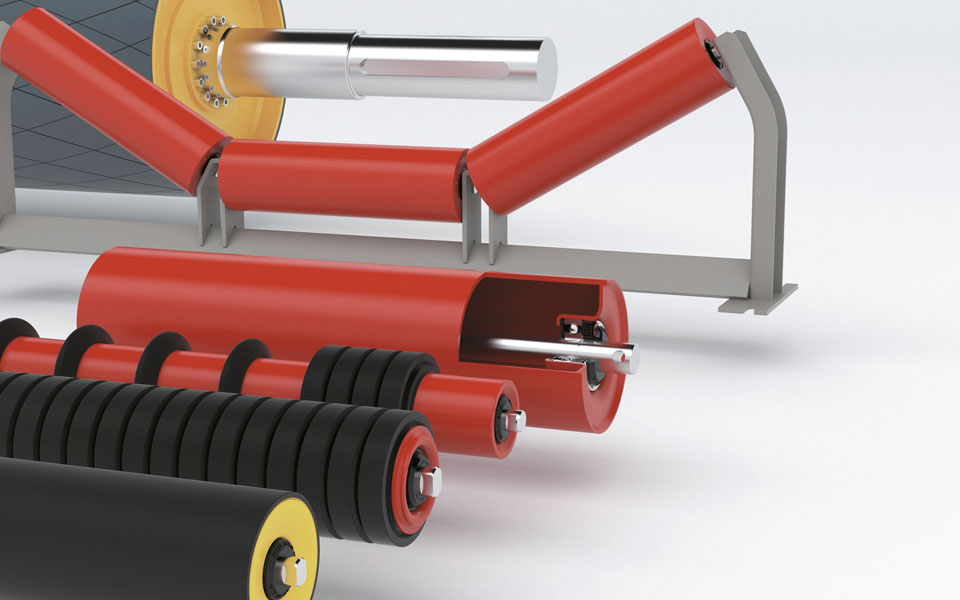Introduction and Application of Carrying Roller
Carrying rollers are one of the most widely used and important components in conveyor belt systems, providing optimal performance. In material transfer lines, metal rollers are used. On a conveyor belt, the carrying roller is one of the components that endures the most friction. If the carrying roller is not placed on a standard level or is not properly balanced, it will have the greatest impact on the conveyor belt and other components.
The sealing structure of carrying rollers is designed to minimize the ingress of water and dust particles. Carrying rollers on the sidewalls of conveyors support the weight of the conveyed material and the belt. Carrying rollers, also known as idler rollers, are crucial components in material handling equipment within conveyor systems.
Applications of Carrying Roller
Carrying rollers are used in various applications, including:
- Rolling and Pipe Manufacturing
- Foundry, Smelting, and Steelmaking
- Chemical and Paper Industries
- Sand, Gravel, and Coal Mines
- Metal and Non-Metal Mines
- Lime, Gypsum, and Cement Industries
- Steel Industry
Features of Carrying Roller
Where are Carrying Rollers Located?
Carrying rollers are used in the following locations:
- Under the Conveyor Belt: Carrying rollers are located under the conveyor belt, allowing the belt to move and carry materials.
- Under the Carried Material: In some cases, carrying rollers may be placed directly under the carried material (loads or cartons). These rollers are designed to withstand the weight of the material above them and assist in material transfer.
- Change of Direction Points: For conveyor belts that require a change in material movement direction, carrying rollers are placed at the change of direction points (end of the belt) to ensure smooth belt passage.
- Lowering and Lifting Areas: In conveyor belts with lowering and lifting mechanisms, carrying rollers play a key role in material handling at points where elevation changes occur.
- Loading and Unloading Areas: Carrying rollers are used in loading and unloading areas to create a flow of materials in a specific direction.
- Areas of Large Loads Transfer: Conveyor belts that transfer heavy loads require high load-bearing carrying rollers to be installed in areas where larger loads pass.
The installation locations of carrying rollers vary depending on the specific transfer needs, the type of material being conveyed, and the type of conveyor system.
Features and Specifications of a Roller
When choosing the right roller, consider the following factors:
- Expected surface wear and abrasion level
- Exposure to technical base fluids, natural oils, and water
- Ambient operating temperature
- Desired speed for feeding material onto the rollers, transportation, and loading
- Equipment dimensions and maximum load capacity
- Weight and physical shape of the load
Reasons for Using Carrying Roller
Carrying rollers are used for various reasons, including:
- Material Transfer: Carrying rollers act as conveyor belt components, facilitating the orderly and proper movement of materials on the conveyor belt. This application effectively and efficiently contributes to material transfer.
- Carrying Heavy Loads: Carrying rollers can withstand heavy loads, enabling equipment to transport heavy materials reliably and without problems.
- Conveyor Belt Protection: Carrying rollers act as supports for the conveyor belt, preventing direct contact between the belt and rough surfaces. This prevents belt wear and tear in the long run.
- Creating Linear Motion: Carrying rollers apply the necessary forces to the conveyor belt to keep it in linear motion, ensuring continuous material transfer.
- Friction Reduction: Carrying rollers reduce friction between the roller surface and the conveyor belt, improving efficiency and reducing energy consumption during the transportation process.
Structure and Sealing Arrangement of Carrying Roller
Carrying rollers undergo the following tests:
- Immersion sealing test
- Balancing test
- Friction test
The sealing structure of the rollers is designed to minimize the ingress of water and dust particles to within standard limits, which is verified by conducting sealing tests.
The sealing parts of the rollers are made of Nylon 6. The bearing housings and roller bodies are made of ST-37 steel, and the thickness of the rollers varies depending on their length and standard. The shaft is made of CK-45, and shaft analysis is provided upon customer request. The dimensional table of the rollers is prepared according to DIN 15207 and ISO 1537 standards.
Components of Roller
The outer surface .

